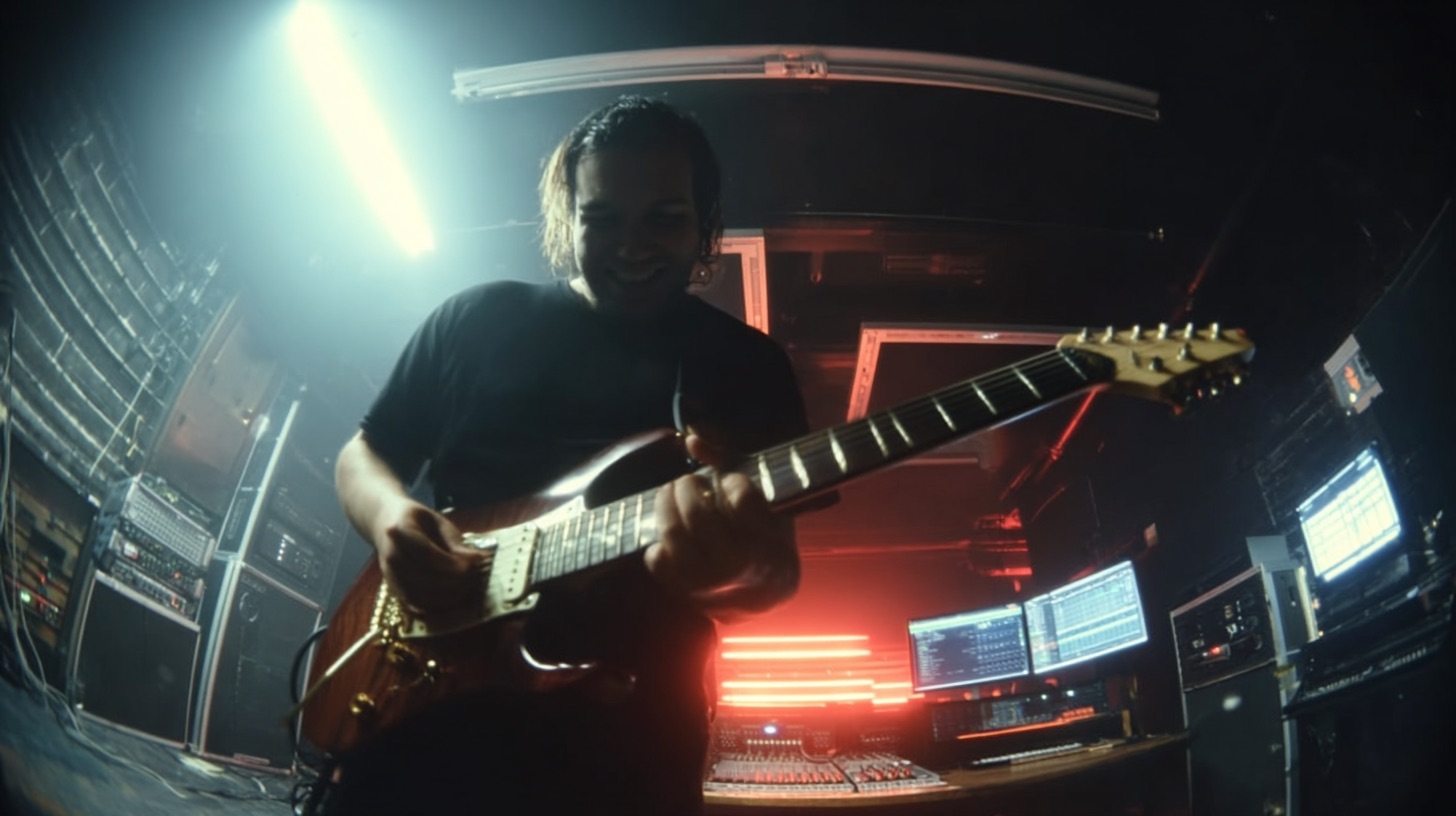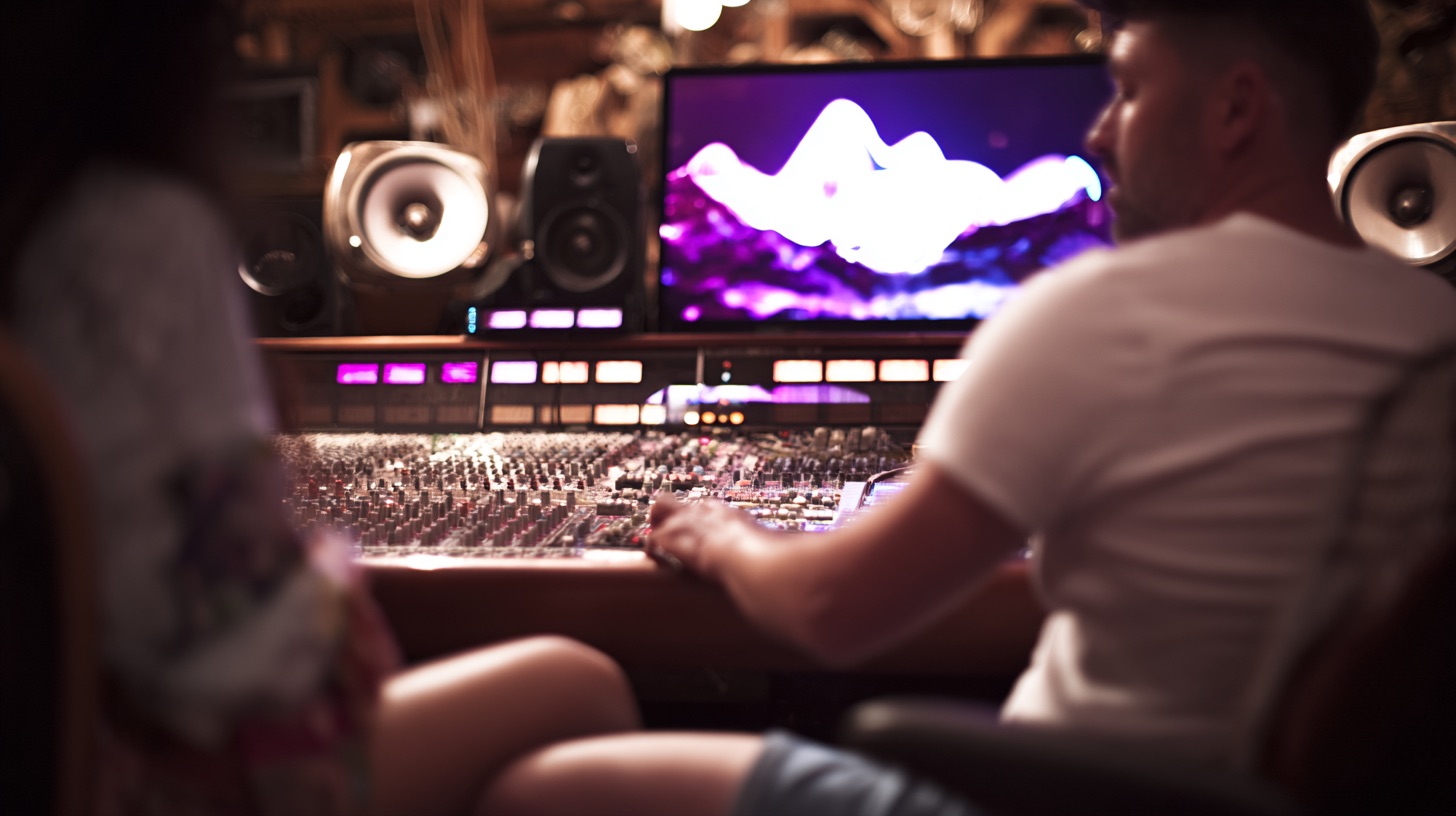
The Perfect Metal Home Recording Studio
Nail The Mix Staff
Alright, let’s cut straight to it. If you’re a metal musician or producer in 2025, your home recording studio isn’t just a convenience; it’s your command center, your sonic laboratory, and your direct line to the global metal scene. Gone are the days when you had to beg for studio time or rely on engineers who thought “scooped mids” was the only trick in the metal playbook. Today, the power to craft brutal, professional-sounding metal is right there in your bedroom, basement, or wherever you can make some noise.
The game has fundamentally changed. The internet blew the doors wide open, making even the most niche subgenres of metal discoverable to a massive audience. You don’t need gatekeepers anymore; you just need a laptop and the drive to create. This has paved the way for a thriving “middle class” of metal musicians – artists who can build a career and connect with fans directly, all from their own well-equipped home base.
The Power Shift: Why Your Home Setup is Your Greatest Weapon
Think about it. Metal, by its very nature, is often extreme, raw, and not exactly radio-friendly. In the past, getting your sound out there meant navigating a system that wasn’t built for us. You’d save up a fortune to go to a big studio, only to end up with a record that sounded sterile because the engineer just didn’t get metal. Or you’d be geographically limited, hoping a decent local producer even existed.
Now? You are in control. The technology to record and produce high-quality metal is more affordable and more powerful than ever. Guys like Buster Odeholm (Vildhjarta, Humanity’s Last Breath) built entire careers from their home setups, crafting some of the most face-meltingly heavy music out there. Look at Devin Townsend – a true visionary who produces, mixes, and engineers his own complex masterpieces, constantly pushing technological boundaries (he just installed a Dolby Atmos room in his space!). They, and countless others, prove that if you have the vision and put in the work, your home recording studio is all you need to bring it to life.
Gear Up: Building Your Metal Home Recording Arsenal
So, what do you actually need to forge your sonic weaponry? The good news is, even “cheap” gear today can deliver surprisingly pro results. The barrier to entry in terms of cost and quality is incredibly low. Let’s break down some options for different budgets.
H3: Budget-Friendly Brutality (Under $1000)
You can absolutely lay down crushing tracks without breaking the bank.
- Interface: A solid 2-channel interface is your starting point. The Focusrite Scarlett 2i2 or PreSonus AudioBox USB 96 are industry standards for a reason. They’re robust, sound clean, and get the job done. Make sure you’re using ASIO drivers on Windows (ASIO4ALL can be a lifesaver for older systems to combat latency).
- DAW (Digital Audio Workstation): Reaper is a monster for metal. It’s incredibly affordable, lightweight, and customizable. Plus, its routing flexibility is insane. Cakewalk by Bandlab is another fantastic option, and it’s completely free.
- Microphones:
- Shure SM57: The undisputed king for loud guitar amps and snare drums. Get at least one.
- Behringer XM8500: A surprisingly decent dynamic mic for harsh vocals or even as a backup SM57.
- Audio-Technica AT2020: A great entry-level condenser for cleaner vocals, acoustic instruments, or even as a room mic in a pinch.
- Headphones: Closed-back headphones are essential for tracking. The Audio-Technica ATH-M40x or Sennheiser HD 280 Pro offer great isolation and decent accuracy for the price.
- Monitors (Optional, but Recommended): If your budget allows, entry-level monitors like the Kali Audio LP-6 (V2) or JBL 305P MkII will be a massive step up from mixing on headphones alone. Even before proper acoustic treatment, they’ll give you a better sense of your low end.
- Pro-Tip: If monitors are out of reach initially, invest in a good pair of open-back headphones for mixing, like the Sennheiser HD560S, and reference your mixes everywhere (car, earbuds, friend’s system).
- Plugins: Your DAW comes with stock plugins that are more capable than you think! Beyond that, explore free gems:
- TDR Nova: A fantastic dynamic EQ.
- Ignite Amps Emissary Bundle: A free, killer high-gain amp sim.
- Softube Saturation Knob: One knob, tons of vibe.
H3: Mid-Tier Mayhem ($1000 – $3000)
Stepping up your game means better conversion, more features, and more refined tools.
- Interface: Look at the Focusrite Clarett+ series, Universal Audio Apollo Solo/Twin (Thunderbolt or USB), or an Arturia AudioFuse. These offer better preamps, lower latency, and often include some decent onboard DSP or bundled plugins.
- DAW: You might stick with Reaper, or explore industry standards like Logic Pro X (Mac only), Cubase Pro, or Pro Tools Artist/Studio.
- Microphones:
- Shure SM7B: A go-to for modern metal vocals. Needs a good preamp with plenty of clean gain (a Cloudlifter CL-1 can help here).
- Sennheiser MD421-II: Excellent on toms, guitar cabs, and even some vocals.
- AKG C414 XLS/XLII (or similar multi-pattern condenser): A workhorse for overheads, acoustic guitars, cleaner vocals, and room mics.
- Headphones: Beyerdynamic DT 770 Pro (80 ohm) for tracking, and DT 990 Pro (250 ohm) for mixing (if you prefer open-back).
- Monitors: Yamaha HS7/HS8 or Adam Audio T7V/T8V are popular choices. At this stage, start thinking about basic acoustic treatment for your room – even DIY panels made with Rockwool can make a huge difference.
- Plugins:
- Amp Sims: Neural DSP Archetype series (Plini, Gojira, Nolly, etc.) are industry leaders. STL ToneHub is also phenomenal.
- Drums: GetGood Drums (GGD) libraries, Slate Digital Trigger 2 for sample replacement.
- Mixing: FabFilter Pro-Q 3 for EQ, ValhallaDSP reverbs (VintageVerb, Supermassive), maybe a subscription like Slate Digital All Access Pass.
H3: Pro-Level Annihilation ($3000+)
This is where you invest in top-tier conversion, flagship microphones, and serious room treatment.
- Interface: Universal Audio Apollo x4/x6/x8, Apogee Symphony Desktop, or an RME Babyface Pro FS / Fireface UCX II. Pristine conversion and rock-solid drivers.
- DAW: Often Pro Tools Ultimate/Studio, Cubase Pro/Nuendo, or Logic Pro X, depending on workflow preference.
- Microphones:
- Vocals: Neumann U87 Ai or TLM 103.
- Guitars: Add a ribbon like the Royer R-121 to pair with your SM57.
- Drums: High-end drum mic kits (e.g., Telefunken TF-DCM-7), dedicated kick mics like the AKG D112 MkII or Shure Beta 52A.
- Headphones: Reference-grade cans like the Audeze LCD-X or Sennheiser HD650/HD600.
- Monitors: Neumann KH120A, Genelec 8030C/8040B, Focal Shape 65 / Alpha Evo series. Professional acoustic treatment for your room is non-negotiable at this level.
- Plugins & Hardware:
- Full UAD suite (if you went with an Apollo).
- Problem solvers like Oeksound Soothe2 or Soundtheory Gullfoss.
- Extensive libraries from Waves, Plugin Alliance, etc.
- Hardware modelers/profilers: Kemper Profiling Amp, Fractal Audio Axe-Fx III.
Beyond the Gear: Techniques That Define Modern Metal
Having the right gear is only half the battle. Knowing how to use it is what separates a demo from a destructive metal masterpiece.
H4: Guitars: Building the Wall of Crushing Sound
- DI is Your Friend: Always, always record a clean DI signal alongside your amped or simmed tone. This gives you ultimate flexibility to re-amp later. Whether you’re using a physical amp, a Kemper Profiler, an Axe-Fx, or plugins like Neural DSP Archetypes or STL ToneHub, that DI is your safety net and creative playground.
- Micing Cabs (If you’re using real amps):
- The Fredman Technique: Two Shure SM57s – one pointed directly at the speaker cone’s sweet spot, the other angled at 45 degrees next to it, aiming at the same spot. Blending these captures punch and aggressive character.
- SM57 + Royer R-121: A classic combo. The SM57 brings the bite, the R-121 adds warmth and body. Experiment with placement – moving a mic even half an inch can drastically change the tone.
- EQ Strategies for Metal Guitars: This isn’t just about scooping mids (though that has its place).
- Surgical Fizz Removal: Use a narrow Q on your EQ (like FabFilter Pro-Q 3) to hunt down and notch out those nasty, harsh high-frequencies (often 5kHz-10kHz+). This cleans up the tone immensely without losing aggression. For more on this, check out our deep dive into EQ strategies for mixing modern metal.
- High-Pass Filtering: Absolutely crucial. Cut out unnecessary low-end rumble (often up to 80-120Hz, sometimes higher) to make space for the bass and kick.
- Low-Pass Filtering: Don’t be afraid to roll off extreme highs above 10-12kHz if they’re just adding noise or harshness.
- Quad-Tracking & Beyond: Layering guitars creates that massive wall of sound. But remember, tight performances are paramount. Sloppy quad-tracking is just a wide mess.
H4: Drums: The Engine of Destruction
- Embrace Samples & Triggers: Let’s be real, modern metal drums are heavily sample-reinforced or replaced. Tools like Slate Digital Trigger 2, Toontrack’s Superior Drummer 3, or GetGood Drums libraries are staples. This isn’t “cheating”; it’s about achieving consistency, punch, and overcoming the limitations of recording drums in less-than-ideal home studio environments. Many bands think they want “all-natural” drums, but the references they provide are often packed with samples. They’re unknowingly buying into the modern sound.
- The Kick Pad Advantage: As Eyal Levi often mentions, using a kick pad (like a Roland KD-7 or similar trigger pad) for drummers can be a game-changer. The drummer still performs the kick part, but you get a clean MIDI signal for triggering samples, eliminating kick bleed into other mics. This allows the drummer to focus their energy on a powerful hand performance (snare, toms, cymbals).
- Editing is Key: Tight, grid-aligned drums are standard. Whether you use Pro Tools’ Beat Detective, Logic’s Flex Time, Reaper’s Stretch Markers, or edit manually, getting your transients locked in is crucial for impact.
H4: Bass: The Unsung Foundation
- DI Dominance: Most metal bass is recorded direct. It gives you a clean, full-range signal to work with.
- The Split Signal Trick: A common technique is to split the DI bass signal into two (or even three) tracks.
- One track for clean, solid low-end (often heavily compressed and low-passed).
- Another track for distorted mids and highs to provide aggression and help it cut through on smaller speakers. Plugins like FabFilter Saturn 2, Soundtoys Decapitator, or dedicated bass amp sims like the Darkglass Ultra plugin are great for this.
- Tune That Thing! Seriously. An out-of-tune bass will ruin a mix faster than almost anything. Use a quality tuner plugin (Melodyne can even tune polyphonically if needed). Bands are often blown away when they hear their bass properly tuned and sitting right for the first time.
- Compression is Your Ally: Consistent bass is key. Multiple stages of compression often work well. Dive deeper into metal compression secrets beyond just making it loud to learn how to make your bass (and everything else) sit perfectly.

100+ Insanely Detailed Mixing Tutorials
We leave absolutely nothing out, showing you every single step
H4: Vocals: Cutting Through the Chaos
- Gain Staging: Get a healthy level into your interface without clipping.
- Strategic Compression: Metal vocals often need aggressive compression to stay upfront.
- Try an 1176-style FET compressor plugin (like Arturia Comp FET-76 or Waves CLA-76) for fast peak control.
- Follow it with an LA-2A-style opto compressor (like Waves CLA-2A or IK Multimedia White 2A) for overall smoothing.
- EQ for Clarity:
- High-pass to remove rumble.
- Cut muddy frequencies (200-500Hz).
- Add presence (2-5kHz) and air (10kHz+) carefully.
- Saturation/Distortion: Parallel processing with a plugin like Soundtoys Decapitator or FabFilter Saturn 2 can add aggression and help vocals slice through dense guitars without having to just turn up the volume.
Embrace the Grind: Knowledge is Your Ultimate Plugin
Owning a home recording studio filled with cool gear is awesome, but the real power comes from knowing how to use it. The internet hasn’t just given us affordable tech; it’s given us unprecedented access to education. The bar for musicianship and production quality is constantly rising because everyone can learn from the best.
This is where Nail The Mix comes in. Imagine watching producers like Will Putney, Jens Bogren, or Nolly Getgood mix actual songs from bands like Gojira, Periphery, and Thy Art Is Murder, explaining every single decision, plugin choice, and technique from start to finish. You get the raw multitracks to practice on yourself. This kind of access was unthinkable a decade ago. It’s about learning the why behind the what.
Don’t be intimidated by new technology or techniques. Legacy bands who were initially skeptical about modern production methods often become converts once they hear the power and polish it brings. If you don’t keep up, you risk your music sounding dated, even to listeners who say they prefer an “old-school” sound. Often, what they truly prefer is a feeling, and if you can marry that feeling with modern clarity and impact, you’ll win every time.
Your Studio, Your Sound, Your Future
The message is clear: It’s an incredible time to be a metal musician with a home recording studio. You have the freedom to craft your vision without compromise, the tools to compete on a global scale, and the resources to learn from the absolute best in the business.
So, embrace the technology. Dive into the learning process. Experiment relentlessly. Your home studio is more than just a room with gear; it’s the crucible where your unique metal sound will be forged.
Ready to take your mixes from demo-quality to release-ready? Want to see exactly how pro metal producers sculpt those massive, aggressive, and polished sounds you hear on your favorite records? Check out Nail The Mix and unlock your sound by learning how to mix modern metal beyond presets. Get access to multitracks from iconic metal bands, hours of in-depth tutorials, exclusive plugins, and a community of like-minded producers.
The power is in your hands. Now go make some noise.
Get a new set of multi-tracks every month from a world-class artist, a livestream with the producer who mixed it, 100+ tutorials, our exclusive plugins and more
Get Started for $1





